| Article Summary: |
|

The 5 Basic Staple Supplements

You see many people using many things. In fact most people use far more supplements than they need to. With so many different products to choose from and being bombarded by advertising from supplement companies it is no wonder that many people do not know what to use and why, choosing to use myriad products, hoping that somehow they will give them the results that they want. The truth is that you do not need all those supplements that you take. Sure, if you are a seasoned veteran trainee or an athlete or someone who has pushed their natural potential to the limit, then that is when it is time to start looking beyond the staples for your needs. Until then, if you are just a recreational trainee or generally active individual, the 'staples' are all that you need.
Each individual uses different staple supplements, from joint support to creatine to a multivitamin. However, there are only five products that can be considered as Basic Staples:
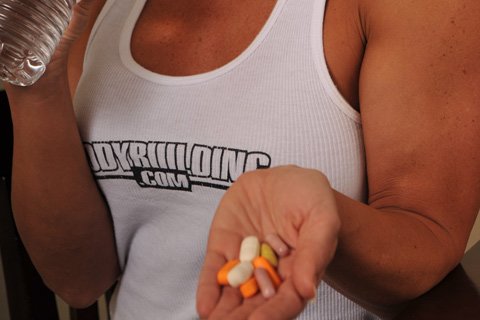
 Click To Enlarge.
Click To Enlarge.
If You Are Just A Recreational Trainee Or Generally Active
Individual,The 'Staples' Are All That You Need.
'Basic staples' means supplements that should be used daily by every trainee. This article will briefly discuss those five basic staples.

Staple 1: Creatine
Creatine is the most highly researched and proven supplement available, and has, in its time, been the latest 'hot' supplement on the market. Hype aside, creatine is a supplement that should be in the arsenal of any individual involved in anaerobic or resistance training, especially as creatine has many functions in the body, including acting as a buffer during anaerobic glycolysis, transport of Adenosine Triphosphate (ATP) during aerobic metabolism, and most importantly, the resynthesis of ATP during anaerobic exercise (Greenhaff, 2000; Hespel, Op 't, Derave & Richter., 2006; Spriet, 1997).
Derived from amino acids, creatine is a compound naturally occurring in the body, and is stored primarily in skeletal muscle. The body has a muscle creatine threshold of ~150-160 mmol/kg/dry weight (dw) of muscle, and because the body only produces 100-150 mmol/kg/dw (Burke, et al., 2006), creatine supplementation allows the body to store up to the muscle creatine threshold. Females have higher natural muscle creatine concentrations than males (Forsberg, Nilsson, Wernemann, Bergstrom & Hultman, 1991).
Although a common practice, creatine loading is unnecessary, as once the creatine muscle threshold is reached, it cannot be saturated further. Also contrary to popular belief, once muscle creatine threshold levels have been reached, supplementation of 2-3g of creatine daily is enough to keep them at threshold. On cessation of creatine supplementation, muscle creatine stores return to resting concentration levels within ~4-5 weeks (Hultman, et al., 1996).
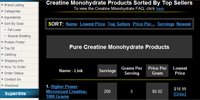 |
Creatine: Sorted By Top Sellers. Creatine is bodybuilding's ultimate supplement, and for good reason. For one thing, creatine can significantly increase lean muscle mass in just two weeks. It is also responsible for improving performance in high-intensity exercise, increasing energy levels, and speeding up recovery rates. [ Creatine Sorted By Top Sellers ] |

Staple 2: Multivitamin
Vitamins and minerals are important to human health (Fogelholm, 2006; Wardlaw & Hampl, 2007). Because of the nutritional practices of today's society many individuals are deficient in vitamins and minerals, and therefore supplementing with a multivitamin is essential to ensure that these needs are being met.
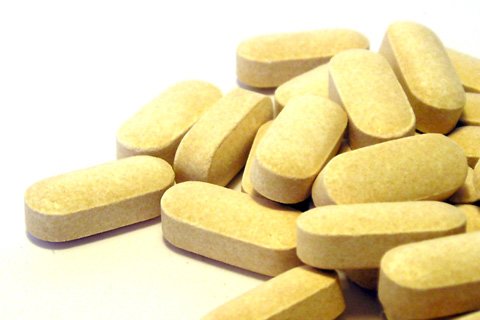
 Click To Enlarge.
Click To Enlarge.
Supplementing With A Multivitamin Is Essential To Ensure
That These Needs Are Being Met.
Organic compounds that are unable to be synthesized by the body, vitamins can be classified as either fat-soluble or water-soluble; whilst minerals are inorganic substances found naturally in the earth, and can be classified as either macrominerals or trace elements (Fogelholm, 2006; Wardlaw & Hampl, 2007).
Vitamins and minerals both have many functions in the body, including buffering, general health, growth, energy expenditure, muscle contraction, immune health, recovery from exercise, and reproduction (Fogelholm, 2006; Wardlaw & Hampl, 2007). To improve their nutritional status and physiological functions, active individuals such as athletes have a higher requirement of vitamins and minerals than the sedentary individual (Fogelholm, 2006), and therefore require a multivitamin supplement with higher levels of minerals and vitamins.
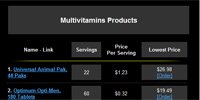 |
Multivitamin: Sorted By Top Sellers. For the human body to perform at its maximum potential, it must be fed a vast and complex array of vital nutrients. Each and every vitamin and mineral is responsible for thousands of biochemical reactions, including the formation of hormones. [ Multivitamin Sorted By Top Sellers ] |

Staple 3: Good Fats
Lipid is an umbrella term for all the different kinds of fat found in the body, including but not limited to cholesterol, steroids, and triglycerides, but for the purpose of this article, the term 'fat' is used (Wardlaw & Hampl, 2007).
One of the three macronutrients essential for survival, fats are used in many of the body's mechanisms for survival, including energy, immune function, forming parts of body structures, insulation and protection of vital organs, vision, and the synthesis of important hormones such as estrogens and testosterone (Wardlaw & Hampl, 2007).
Fats are made up of fatty acids. 'Good' fats, also known as monounsaturated and/or polyunsaturated fats, are liquids at room temperature, and include the essential fatty acids (EFAs) omega-3, omega-6, and omega-9 (Wardlaw & Hampl, 2007).
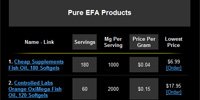 |
Essential Fatty Acids: Sorted By Top Sellers. Fats can be broken down into two basic groups, saturated and unsaturated. More importantly, fats can be labeled as essential and nonessential. Essential fats must be consumed through ones diet because the body cannot synthesize them. [ Essential Fatty Acids Sorted By Top Sellers ] |

Staple 4: Protein Powder
Protein makes up the major component of the body, second only to water in the tissues of the body, making up 17% of the body's lean tissue. The building blocks of protein are called amino acids. Dietary protein is usually the source of amino acids for the body, especially of the essential amino acids, which the body cannot synthesize sufficiently to maintain physiological processes by itself (Wardlaw & Hampl, 2007).
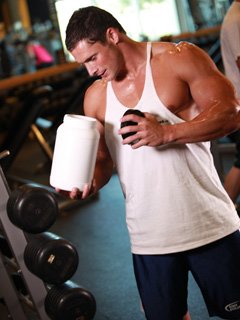
 Click To Enlarge.
Click To Enlarge.
Protein Makes Up The Major Component Of The Body, Second
Only To Water In The Tissues Of The Body.
Protein has many functions and roles in the regulation and maintenance of the body, including but not limited to, forming vital body structures, energy, blood clotting, immune function, acid-base balance, fluid balance, contributing to satiety, hormones and enzyme production, and muscle growth. Because most of the body's lean tissue is comprised of muscle, and adequate protein must be available for amino acids to provide protein synthesis since muscle is primarily protein and water (Wardlaw & Hampl, 2007).
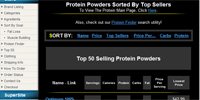 |
Protein Powders: Sorted By Top Sellers. Protein powders are formulated to be the perfect meal in a quick and easy shake. It is easy to take them with you to work or school or anywhere that you need. [ Protein Powders Sorted By Top Sellers ] |
According to studies done (Tarnopolsky, 2006) the general population require only 0.8g/kg/day of protein, with bodybuilders and those trying to gain muscle mass require higher amounts, ranging from 1.0-1.2g/kg/day for those who do their resistance training in a steady-state, and as much as 1.5-1.7 g/kg/day for those who train in the early morning or in a fasted state (Tarnopolsky, 2006; Tarnopolsky, et al., 1992). Most individuals will be able to get their daily protein requirements from food. However, those individuals whose daily protein requirements mean that they need to consume in excess of 20-30g of protein per meal, can find eating the amount of food required strenuous and inconvenient; therefore, supplementing with a protein powder can alleviate much of the hassle, without sacrificing the quality of protein ingested. Often, using a protein powder can be convenient for any individual, especially if one has time constraints or leads a lifestyle where they are always on the go.

Staple 5: Branched Chain Amino Acids
As already mentioned, amino acids are the building blocks of protein. Branched chain amino acids are the essential amino acids leucine, isoleucine, and valine. Essential amino acids cannot be synthesized by the body and must be obtained through either food or supplementation (Wardlaw & Hampl, 2007).
Like protein, branched chain amino acids have many functions within the body, but are primarily involved with energy, and can provide an instant energy source, especially when muscle glycogen stores are depleted (Wardlaw & Hampl, 2007).
Supplementing with 10-30g of branched chain amino acids daily can help the active individual in sparing muscle glycogen and in aiding recovery from exercise (Wardlaw & Hampl, 2007), especially if training in hot environments (MacLean, Graham & Saltin, 1996; Tarnopolsky, 2006).
 |
BCAAs: Sorted By Top Sellers. Essential amino acids cannot be made by the body. You must get them from complete protein foods or combinations of incomplete vegetable foods. [ BCAAs Sorted By Top Sellers ] |

Conclusion
The average individual does not need supplementation, except for perhaps a multivitamin to ensure that they do not get any mineral and vitamin deficiencies. However, the more active individual, recreational trainee, or competitive athlete needs more than simply what they can ingest through their nutrition. Of the many supplement products available on the market, only five are essential and should be considered 'staples' in one's supplement regime.
Creatine is required for ATP resynthesis, and is especially important for those involved in anaerobic and/or resistance training. A multivitamin is essential for everyone to ensure that their daily mineral and vitamin needs are being met, with the active individual requiring more of certain minerals and vitamins to improve their nutritional status and physiological functions. Good fats are necessary for many of the body's mechanisms for survival, especially in the synthesis of hormones. Protein makes up the major component of the body, second only to water in the tissues of the body, with many functions and roles in the regulation and maintenance of the body. Branched chain amino acids cannot be synthesized by the body and must therefore be consumed through the diet, with extra supplementation of them providing an instant energy source and aiding in recovery.
So, before you go searching for other supplements, make sure that you have the basic staples!
References:
- Burke, L., Cort, M., Cox, G., Crawford, R., Desbrow, B., Farthing, L., Minehan, m., Shaw, N. & Warnes, O. (2006). Supplements and sports foods. In L. Burke & V. Deakin. (Eds.). Clinical sports nutrition (3rd ed.). (p. 485-579). NSW, Australia: McGraw Hill.
- Fogelholm, M. (2006). Vitamin, mineral and anti-oxidant needs of athletes. In L. Burke & V. Deakin. (Eds.). Clinical sports nutrition (3rd ed.). (p. 313-342). NSW, Australia: McGraw Hill.
- Forsberg, A. M., Nilsson, E., Wernemann, J., Bergstrom, J. & Hultman, E. (1991).Muscle composition in relation to age and sex. Clinical Science, 81. (p. 249-256).
- Greenhaff, P. L. (2000). Creatine. In R.J. Maughan (Ed.). Nutrition in sport. (p. 367-378). Oxford: Blackwell Science.
- Hespel, P. Op 't, E. B., Derave, W. & Richter, E. A. (2001). Creatine supplementation: Exploring the role of the creatine kinase/Phosphocreatine system in the human muscle. Canadian Journal of Applied Physiology, 26(Supplementary). (p. S79-S102).
- Hultman, E., Soderland, K., Timmons, J. A., Cederblad, G & Greenhaff, P. L. (1996). Muscle creatine loading in men. Journal of Applied Physiology, 81(1). (p. 232-237).
- MacLean, D. A., Graham, T. E. & Saltin, B. (1996). Stimulation of muscle ammonia production during exercise following branched-chain amino acid supplements in humans. J Physiol Lond, 493. (p. 909-922).
- Spriet, L. L. (1997). Ergogenic aids: Recent advances and retreats. In D. R. Lamb & R. Murray (Eds.). Perspectives in exercise science and sports medicine. (p. 185-238). Carmel, Indiana, USA: Cooper.
- Tarnopolsky, M. (2006). Protein and amino needs for training and bulking up. In L. Burke & V. Deakin. (Eds.). Clinical sports nutrition (3rd ed.). (p. 73-111). NSW, Australia: McGraw Hill.
- Tarnopolsky, M. A., Atkinson, S. A., MacDougall, J. D., Chelsey, A., Phillips, S. & Scharcz, H. P. (1992). Evaluation of protein requirements for trained strength athletes. Journal of Applied Physiology, 73. (p. 1986-1995).
- Wardlaw, G. M. & Hampl, J. S. (2007). Perspectives in nutrition (7th ed.). New York, New York, USA: Mc-Graw Hill.
Recommended Articles
| Share This Article: |



